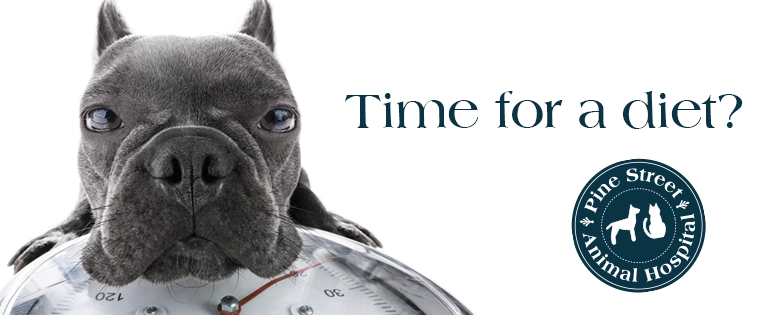While most of our dogs were bred for sport, hunting or working in the fields, in reality, they usually spend more time napping on our couches. With their often idle lifestyles and regular access to tasty treats, it’s not surprising that 54% of American dogs are overweight or obese. Is your dog one of those? If so, there are some key steps you can take to help your overweight dog eat better and exercise more in order to have a longer, healthier life.
Confused About Dog Food? We Can Help.
Is my dog overweight?
Whether your dog is fluffy or sleek, tall or low to the ground, there are clues to whether or not she has put on some extra pounds. How can you tell if your dog is overweight?
First, give your dog a light stroke down his side. For a dog of healthy weight, you should be able to feel all of his ribs easily. Then step away to look at him from the side. You should see the line of the chest curve upward at the stomach (if it pooches down or even drags, you’re likely looking at problematic obesity). Another way to check for a healthy weight is to look at your dog from above. You should see an hourglass curve, not an avocado. (Find helpful drawings of dog sizes on the APOP webpage).
If you’re not sure about your dog’s healthy weight or size, ask your veterinarian.
Why does weight matter?
While your dog’s large girth might look cute, it can actually be causing severe health problems. Obesity in dogs can lead to Type 2 diabetes, heart disease, arthritis, respiratory problems, skin problems, and reduced life expectancy. Don’t ignore signs if your dog begins to gain weight or carries around excess weight. It’s up to you to help your dog lose the weight to become healthier.
Start with the food.
The first way to help your dog lose weight is to regulate food. These tips can help you feed your dog in ways to encourage health and discourage obesity:
- Do not give excessive treats or human food to dogs. We know this is challenging, but your dog does not need any table scraps. Additionally, small, made-for-dog treats are fine to give for training endorsement, but if you’re giving lots of treats, be sure to reduce the amount of meal-time food.
- Try making your dog work for food by using puzzle bowls or hiding food in safe containers.
- If you have more than one dog, separate them at feeding time to ensure that one dog isn’t eating the other’s food.
- Use set feeding times and remove food that the dog hasn’t eaten within 10 minutes. Do not allow dogs to graze on food all day.
- Buy healthy dog food and avoid the cheapest brands at the grocery store. But what is healthy? This is a good question to discuss with your vet. Some dogs may benefit from food with no or reduced grains, while others may need leaner protein. And severely obese dogs may be prescribed special diet food. All that said, some dogs may do best by continuing their regular food, but eating less of it.
Next, increase exercise.
Just like with humans, it’s best to have a weight-loss plan that includes diet and exercise. So how can you get your dogs to exercise more? First, set aside time to exercise with your dog. Take at least one long walk each day (find some great destinations on our list of Spartanburg’s best dog-walking trails), and try for longer walks on weekends or days you have more time. If you have a fenced-in yard, don’t rely on that as your dog’s only time to run and be outdoors – you need to take your dog out to get the exercise he needs. Next, add some play into your dog’s day. Find toys she likes, like balls or tug toys, and spend some time each day playing with your dog. Your dog would also love a chance to romp with other dogs at the dog park.
And finally, try not to leave your dog at home for too long. Include your dog on walks to the post office or grocery, take her on your vacations, and bring her along for visits to friends’ houses (if she’s well behaved and welcome). If you have to leave your dog home for long hours due to work or other obligations, consider hiring a dog walker to ensure your dog gets exercise and time to use the bathroom in the middle of each day.
Be consistent and patient.
Weight loss in pets takes a long time; rarely will you see immediate results. For most dogs, making a few changes to diet and exercise will lead to weight loss, which can greatly improve the health of your dog. So even if you don’t see your dog getting skinnier right away, keep up the efforts. Your dog will thank you for it.
Dr. Adcock is happy to discuss the best types of food for your dog, and whether or not he or she needs a special diet or exercise plan. Contact us today for an appointment.



